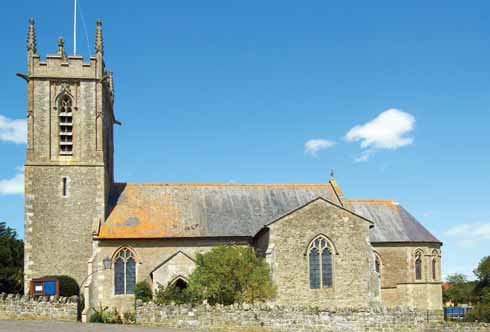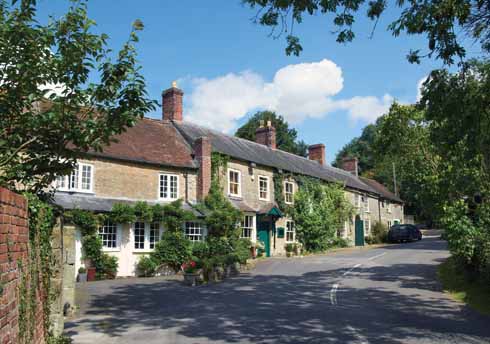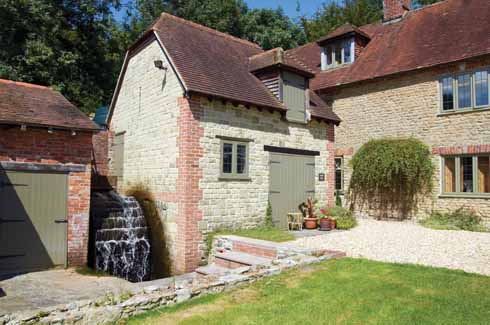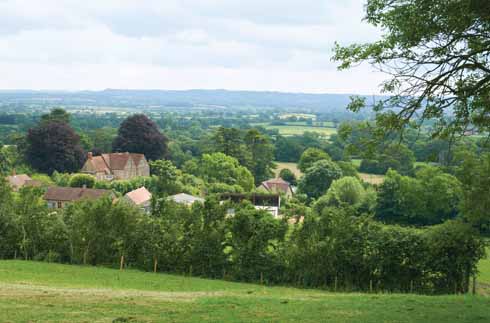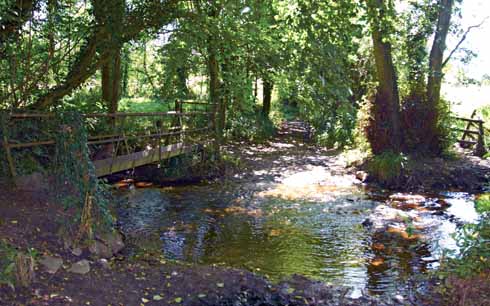Bourton and Chaffeymoor: Booton Foot trails
Peter Booton visits Dorset's most northerly parish
Published in October ’12

Iron wheel from a Warwickshire coal mine which was manufactured in the foundry at Bourton, and now graces the entrance to Farcombe Hall, the home of Dr. George Maggs whose predecessors owned Bourton Mill in the 1800s
Bounded by Somerset to the west and Wiltshire to the east, Bourton is the most northerly parish in Dorset. The 922 acre parish, which includes the hamlets of Chaffeymoor and Sandway, was a Chapelry of Gillingham until the early 19th century. The perpendicular style Parish Church of St George was consecrated in 1813 and stands at the western side of the village. Only the original foundations of the building remain following a complete rebuild of the church in 1879-80.
Bourton takes its name from the Old English ‘burh-tun’, meaning ‘fortified farmstead’ and may have originally consisted of two settlements. Present day Bourton and West Bourton are divided by the A303 trunk road which opened in 1992 to relieve the village of heavy congestion on the old A303 London to Exeter road passing through it.
West Bourton lies south of the A303 and is predominantly agricultural land on Corallian Limestone, whereas the more populated main part of Bourton village is north of the trunk road on a bedrock of mostly Greensand. The River Stour, which rises little more than two miles north of the village on the National Trust owned Stourhead Estate in Wiltshire, flows through Bourton and has played a significant role in the prosperity of the village.
A mill at Bourton, the highest on the Stour, is mentioned in the Domesday Book and this is possibly the predecessor of Bourton Mill which was processing flax for the linen industry during the 1800’s and supplying sailcloth to the British and Russian navies at that time. In 1811, when 159 families were recorded as living in Bourton, three-quarters of the village’s population was involved in the weaving of linen. The local land-owning Maggs family owned Bourton Mill for many years and they were responsible for building a foundry alongside the existing flax mill which, in 1844, was being run by Daniel Maggs, a ‘tick & dowlas, sailcloth and shoe thread manufacturer & bleacher’. At that time Oliver Maggs was developing the foundry and manufacturing agricultural machinery. Three waterwheels were operating on the site and the largest, at 60 feet in diameter, was reputed to be the largest in England.
However, linen manufacture at Bourton Mill declined due to fierce competition from factories in the north of England. In the 1860’s the foundry was taken over by E S Hindley & Son. The Post Office Directory of 1875 records that Edmund Samuel Hindley was an ‘engineer, millwright, iron founder, boiler and agricultural implement manufacturer’. The company’s diverse range of products, which also included steam lorries, were exported throughout the world. At one time, around 200 people were employed at the factory. Theodore James Biggs, who served his apprenticeship at E S Hindley & Son, went on to become the first draughtsman at the Raleigh Cycle Co. in 1892. As well as developing bicycles and motorcycles for Raleigh, T J Biggs also produced a design for their first prototype car in 1905.
During the First World War the premises became a munitions factory where more than three million Mills bombs were made between 1914 and 1918. When Gasper dam upriver on the Stour burst in June 1917, the foundry was severely flooded and machinery damaged. The foundry ceased to operate in the late 1920s when the company was purchased by Alfred Dodman & Co and the manufacturing base was transferred to King’s Lynn. Six years later the premises became a processing plant for milk products under various owners, including United Dairies, until the end of the 20th century when its last owner was Mr John Freeman. The now derelict mill and foundry buildings are owned by a developer who proposes to build a number of houses on the site.
John Freeman created a 25-acre private golf course on land alongside the factory which was opened to the public in 1991 as Bullpits Golf Club. The 60 par course covers 3,132 yards and is claimed to be ‘the south-west’s most challenging short course’. Since it was taken over by Gerry and Cathy Price in late 2006, the new owners have initiated a number of improvements. The River Stour flows through the course and alongside Egbert’s Stone which marks the meeting point of the counties of Dorset, Somerset and Wiltshire. Egbert of Wessex, the ruler of the West Saxon kingdom and grandfather of Alfred the Great, is reputed to have erected the small megalith and, later, assembled his troops at the stone prior to his victory over the Danes at the Battle of Edington in 878AD.
An indication of Bourton’s prosperity during the heyday of its linen industry is evident from the numerous 18th- and 19th-century fine stone houses and cottages that are scattered throughout the village. On the walk we pass Chaffeymoor House, dating from around 1700, The White Lion Inn (1723), a traditional pub with old beams, and evocatively named Weavers House in Brickyard Lane. We also encounter Silton Mill alongside the River Stour, Ainslie House at Crossroads which has been converted into a private dwelling from an 1880s Methodist chapel, and the home of Dr George Maggs in Kite’s Nest Lane whose predecessors owned Bourton Mill in the 19th century. At the end of the private drive to his interestingly named home are the two semi-circular sections of a large iron wheel that worked at a coal mine in Warwickshire before being returned to its present location alongside the site of the foundry where it was made.
The walk:
1. Park in the lay-by beside the ‘Bourton’ sign on the old A303 where the county boundaries of Wiltshire and Dorset meet. Walk west to the crossroads and turn right into High Street. Follow the road uphill past The White Lion and opposite Bourton House go left through a kissing gate into a field. Follow the faint track across the field in a westerly direction to the far side where you go through a kissing gate onto a downhill grass track. Follow this to a single wooden gate leading onto Bridge Street.
2. Turn left (opposite entrance drive to Bullpits Golf Club) and follow road downhill to reach the site of former Bourton Mill and foundry on your right. Go past the derelict buildings and turn right into Kite’s Nest Lane.
3. After 30 yards turn right and go through a kissing gate onto a footpath (The Stour Valley Way) alongside the entrance drive to Farcombe Hall, the home of Dr Maggs. Note the stone plaques on the pillars at the end of the drive which commemorate the manufacture of three million Mills bombs at the factory during the First World War. Follow the path to its end at a single metal gate. Enter the next field and keep to the right side. After 50 yards at fork on track, head uphill to left corner of field (this grassy path is approximately the boundary between Dorset and Somerset) and cross wooden stile onto a path alongside the private garden of Kite’s Nest Cottage. At the end of the path exit through a white five-bar gate and go left onto Kite’s Nest Lane.
4. After 40 yards turn right up steps onto a track leading through a kissing gate into a field. Head towards the centre of the far side, noting the panoramic views south, beyond Bourton village, of the Blackmore Vale. Go through a kissing gate into a field and head towards the top right of the far side where you cross a stile into the next field.
5. Head for a full-height metal kissing gate and go through this onto a path through dense coniferous woodland. Exit through a second full-height kissing gate and proceed along a woodland path to cross a stile into a field. Keeping to the left side (Chiffchaffs Garden is on your left), cross stile at end into next field. Continue along track on left side to end and cross stile onto a path to the left of a derelict stone cottage. On reaching an open field, head downhill towards houses where there is a stile in the hedge.
6. Cross stile to reach private drive and go left for 10 yards to public footpath on your right which leads to Chaffeymoor Lane. Pass the entrance to Chiffchaffs Gardens and continue along the lane past Chaffeymoor Grange and Chaffeymoor House.
7. At the end of the lane, go left alongside the old A303 and carefully cross the road to a footpath which reaches the Parish Church of St George.
8. Continue along the footpath beside the main road and after passing St George’s C of E School and Bourton’s war memorial, take the right fork into Brickyard Lane. Follow the lane past stone cottages and Weavers House, on the right, to the end of the lane where you go through a metal farm gate onto a bridleway.
9. Fork right on track at first metal farm gate signed ‘Private’ and continue along bridleway to reach fork at metal farm gate ahead where go right on track through woodland. On reaching the stile ahead, don’t cross but go left and through single wooden gate into a field. Keep to the left side and at end of field go through a kissing gate and then over a footbridge crossing the River Stour to a lane which passes Silton Mill. At the end, go left onto Silton Road, passing Ainslie House and the old school-house on your left.
10. Follow Silton Road to its junction with Crossroads at the old A303. Go right on footpath alongside the main road and return to your vehicle in 300 yards.
Distance: 3.5 miles.
Terrain: Easy going with only gentle ascents. Mostly grass fields, bridleways, metalled roads and woodland paths.
Start: Lay-by on old A303 at eastern end of Bourton. OS grid reference ST779 309.
Postcode SP8 5AT (The White Lion Inn).
How to get there: Leave the A303 (T) between Zeals and Mere. Follow signs for Zeals and Bourton. The lay-by is on your left approx. ½ mile west of Zeals village.
Map: OS Explorer 142 Shepton Mallet and Mendip Hills East. OS Landranger 183 Yeovil & Frome.
Refreshments: The White Lion Inn, High Street, Bourton SP8 5AT.
Public Transport: South West Coaches service 158 Wincanton – Shaftesbury, operates Monday-Friday and Saturdays. The bus stop is on the old A303 alongside St. Georges School.
Note: If arriving by bus, commence the walk at point 8, above.
